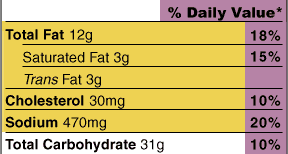An Inconvenient Fat
Disclaimer: I am not a medical doctor, nutritionist, herbalist, doula, or massage therapist. I am just some guy with a blog. Consult your own medical professional and/or megacorporate lobbyist before determining what is right for you, your heart, and your arteries.
Few topics irk me more than trans fats. Trans fats (specifically artificial trans fats which are my focus in this post) are what give tasty junk food an incredible shelf life. Chances are good that if you eat fattening prepackaged foods with creaminess or super smooth texture, you’re enjoying the wonders of trans fats. Many commercially fried foods, like chicken and donuts also contain trans fats.
What’s Wrong With Trans Fats?
There are an overwhelming number of things to worry about in my diet every day. There’s high fructose corn syrup (HFCS) in just about everything these days. There’s even mercury in fish. What the hell am I supposed to eat?
Grocery shopping in our household is difficult. We’ve had to make compromises from time to time. There are several things we don’t eat. HFCS is one we absolutely avoid. We’re less radical about other ingredients, but still shy away from prepared foods with nitrates or soy-based ingredients. If you are in the habit of looking at the ingredients while shopping, you can imagine how many items we put back on the shelf.
Trans fats have a special place on our no-fly list though. Unlike many other troubling ingredients in foods, trans fats accumulate in the body. For example, if I eat something with HFCS I may have a crazy sugar high but then I’m done. The HFCS is metabolized and will leave my body. (Or turn into fat on my ass, whichever.) Trans fats, however, have a hard time leaving the bloodstream and even worse, trans fat molecules like to wedge into arterial walls, contributing to coronary heart disease.
This is very frustrating to me. From the time I had my own money to spend as a kid up until a few years ago, not a day passed where I wasn’t pounding trans fat crap into my pie-hole. Which means that not only was I eating poorly and packing on the pounds, I was doing direct, permanent harm to my arteries and my heart!
How to Spot a Trans Fat

Trans fats are delivered primarily in hydrogenated oils. Most often you’ll see the ingredient listed as “partially hydrogenated vegetable oil”, although sometimes the particular variety of oil will differ (palm, sunflower, canola, etc.). A few years back the FDA added a separate line item on the Nutrition Facts panel for trans fats. So now if you want to know if a product has trans fats you can just look at the Nutrition Facts and it will tell you. Well, sort of. See, there’s a catch.
The FDA Gets Metaphysical
Unfortunately the Nutrition Facts doesn’t tell the whole story. While it is true that trans fats have their own line item in the Nutrition Facts panel, it doesn’t tell the entire truth. I don’t know the full story, so I’ll try not to be judgmental of the FDA (see my disclaimer above). What I know is that the food industry was rightly concerned that no one would buy products with trans fats in them. Also, they were having a hard time eliminating trans fats from their products while retaining product consistency and shelf life. So the FDA made a compromise. Food manufacturers can claim that their food has “0g trans fats per serving” if the food has less than 0.5g of trans fats per serving. I think the FDA sees this as just a matter of rounding numbers down. As a numerate consumer it means zero != 0. Which is more than a little confusing.
Products can now proclaim “zero trans fats!” on the package, and what they actually mean is that their product has less than 0.5g of trans fats per serving. I’ve had several conversations over the past few years with people who tell me I’m crazy for not eating a product because the package clearly says “no trans fats”. When I point at the partially hydrogenated oil in the ingredients I just get a blank stare.
SOYLENT GREEN IS TRANS FATS!!

Can you imagine if the FDA had an equivalent rule for ingredients that caused allergies?
“0g wheat gluten!”
“no peanuts”“I can’t imagine why I had an allergic reaction to these chips. They said no peanuts!”.
“Ah, that’s no peanuts *per serving*, sir!”
Where Is the Point of Diminishing Returns?
Certainly there are safe or near-safe levels of consumption for just about any bad thing. What is the safe level for trans fats? I don’t think it is 0.5g per serving. That’s just a hunch. Again, I refer you to my disclaimer above.
The real problem with the FDA rules for labeling is that we don’t get to find out how much trans fat is in any given product that claims to be “trans fat free”. All we are allowed to know is that the quantity is under 0.5g per serving. So it could be 0.4999g or it could be 0.0001g per serving. There is no way for the consumer to know.
My Wife Thinks I’m Crazy
And you may think I’m a bit crazy also. But I’m not alone. The country of Denmark is crazy too. Denmark outlawed trans fats 5 years ago. Switzerland is apparently also crazy, since they followed Denmark’s lead. And now local governments around the US are starting to ban foods with trans fats. So I may be crazy, but the crazy is spreading.
Let’s Zero In on the Problem
In a perfect world we wouldn’t be forced to ferret out fake food from our diet. Since we have to live with fake food for now, it would be nice if we could have a system where the exact amount of artificial trans fats per serving could be stated. It would also be nice if the “zero” was returned to it’s rightful state of literally meaning “none” instead of “a little bit”. At the very least we should make food manufacturers declare “very low trans fats” instead of “zero trans fats”. Specific numbers about trans fat content would be nice too. Then we would be on the right track.
